If you’ve ever seen a Zen Buddhist sitting cross-legged in quiet meditation, what he or she might have been doing is called zazen -- “a means of insight into the nature of existence,” per Wikipedia, which goes on to say: “The aim of zazen is just sitting, that is, suspending all judgmental thinking and letting words, ideas, images and thoughts pass by without getting involved in them.”
The Canadian company IsoAcoustics Inc., makers of the Orea isolation footers ($59.99 each, all prices USD), which I placed under some Paradigm Monitor SE Atom speakers and wrote about for this column in October 2018, seems to have been inspired by zazen -- which they define simply as “sitting meditation” -- in the design of their two new isolation platforms, the zaZen I ($199.99) and zaZen II ($229.99).
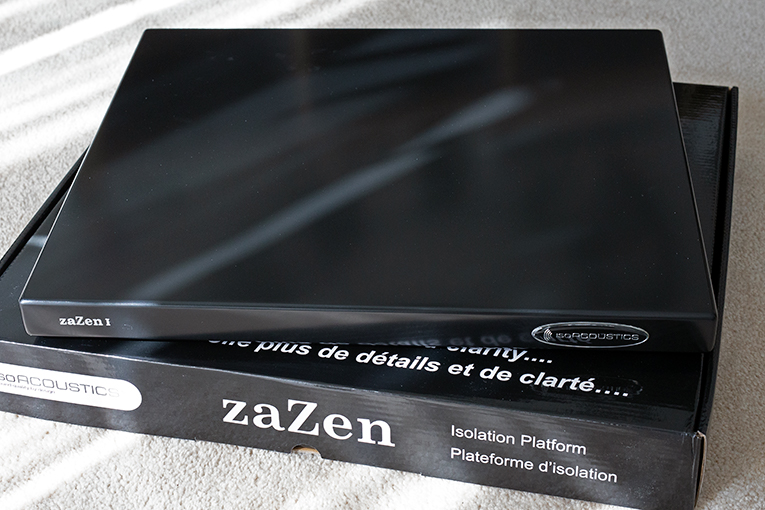
Of all audio components, the turntable is the most vulnerable to vibrations from its surroundings, and so most benefits from isolation from those vibrations. Both zaZens are primarily designed to support a turntable, but can be used for other component types. The zaZen I measures 17”W x 1.5”H x 15”D and can support up to 25 pounds. The zaZen II, 1.65”H but otherwise identical in dimensions, can support a turntable or other component weighing as much as 40 pounds. I requested for review a zaZen I -- the turntable I used it with in this iteration of System One, Pro-Ject Audio Systems’ X1, weighs just over 15 pounds.
The two zaZens, available only in black, share the same construction. Each is made of dense fiberboard coated with polyurethane paint and UV-cured lacquer. The finish seems reasonably durable, and cleans up easily with a soft cloth and water. Each platform is in turn supported by four small, round, black-and-red footers IsoAcoustics designed for the zaZens: “Combining the mass from the dense platform with the IsoAcoustics isolators creates a high degree of isolation.” IsoAcoustics doesn’t say what these footers are made of, but the bottom, flat-black disc seems to be of rubber or plastic, the upper, red disc of urethane or something similar. The black disc felt moderately hard when I stuck a fingernail into it, but I could squeeze the red disc -- it gave more than does a soft skateboard wheel, not nearly as much as a Gummy Bear. When I pressed down on the zaZen I, it had a bit of give, but didn’t bounce as if sitting on a cushion of air.
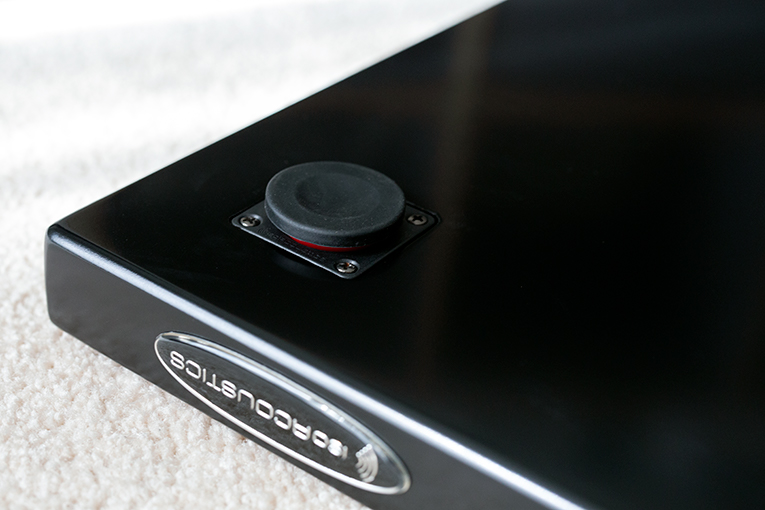
Such simple construction might make you wonder how a slab of painted board with four little footers, proprietary or not, could be worth $199.99, let alone $229.99. It crossed my mind that any reasonably handy person could haul off to Home Depot with a lot less cash in pocket, pick up some parts, and DIY it.
Then again, the same thing had crossed my mind almost 30 years before, when I first saw one of the Quarter Round TubeTraps still made by the Acoustic Sciences Corporation, aka ASC. A TubeTrap is designed to be placed in the corner of a listening room, to absorb excess bass energy. It’s a wooden frame covered with absorptive fiberglass and cloth, with wooden endcaps -- all stuff easily found at building-supply and fabric stores. I think the price then was about $400 each, and I needed three.
I turned to a friend I’d brought along, a handyman and audiophile. “I bet I could build them all for 50 to 100 bucks, tops.”
“Maybe,” he replied, “but try and see how long it takes you, and if it looks as good when you’re finished -- and if it works as well.”
In one sentence, my friend had made three good points. I realized that while ASC’s price was high enough for me to question it, it wasn’t so high that I wanted to go and build my own version, on the slim chance that it would be identical in look and function. Nor did I want to spend the time finding out. So I asked the store for a small discount. They obliged, I bought the three Quarter Rounds I needed, and I use them still.
Buy or build a zaZen I? I’d buy.
Times change, systems change
But you shouldn’t buy or build something like a zaZen unless you actually need it. Obviously. These days, the turntables I review for this column don’t need so much isolating, because I no longer place speakers on the same IKEA Kallax shelving unit as my turntable and amps. But when I did, I needed something like the IsoAcoustics Orea footers I reviewed, which worked very well.
Now I use speaker stands when I review minimonitors, or the floor if I’m reviewing towers. I’ve switched from a U-Turn Orbit Plus turntable to a Pro-Ject X1, which I wrote about last month. The Orbit Plus had rubber feet; the X1 has height-adjustable feet of machined aluminum with felt bottoms that Pro-Ject claims damp vibrations from the surface they sit on.
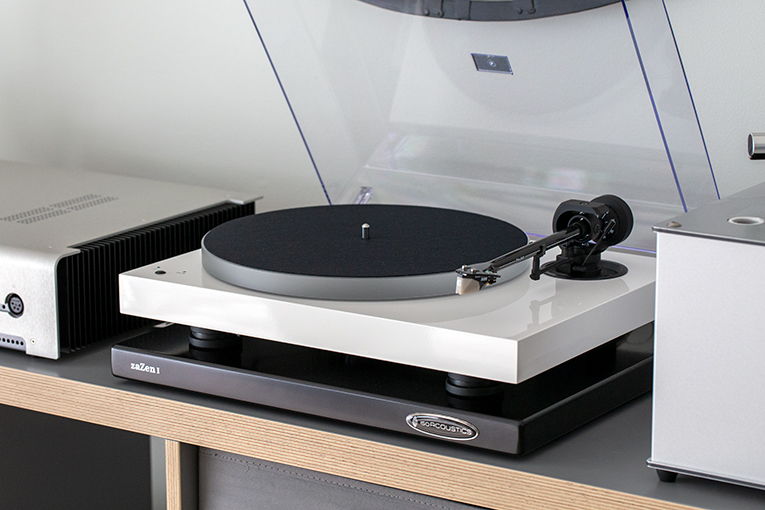
I still set my electronics and turntable on an IKEA Kallax shelving unit, which is lightweight, not that sturdy, and prone to vibration. I hoped the zaZen I would help.
Hands-on listening tests
The first thing I noticed when I placed the IsoAcoustics zaZen I atop the Kallax and the Pro-Ject X1 atop the zaZen was how much grander the turntable now looked -- as if showcased. Before digging out some records to play, I took a few moments just to admire the Pro-Ject sitting on its new perch.
That version of System One also comprised Schiit Audio’s Ragnarok 2 integrated amplifier, into whose moving-magnet phono stage I plugged the X1’s stock phono cable; and NHT’s C 3 Carbon Fiber speakers sitting atop 24”H Monoprice Monolith stands and connected to the Ragnarok 2 with QED XT25 speaker cables.
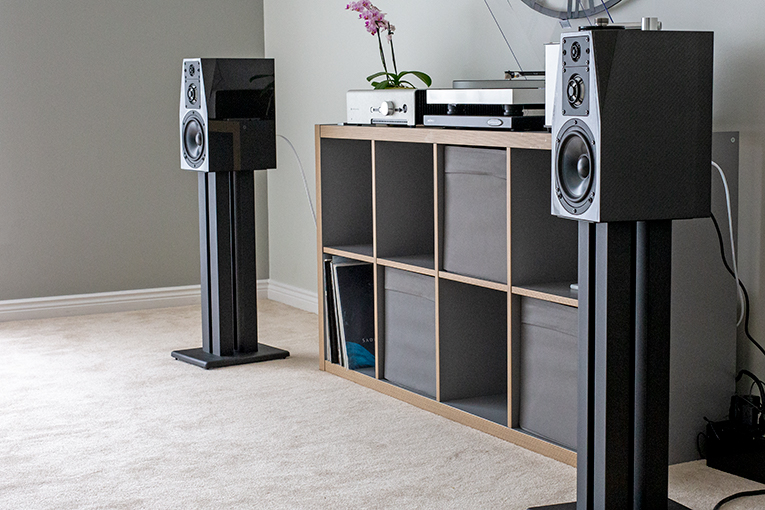
I began by playing Sade’s “Mr Wrong” -- track 1 on side 2 of Promise (LP, Portrait FR 40263). A few seconds in, I took a step back from the Kallax and stomped lightly on my floor (carpet over wood). The stylus didn’t skip. I stomped a little harder. This time it skipped, but that didn’t surprise me. I knew from having felt them that the zaZen I’s little footers wouldn’t provide enough cushioning to absorb a big shock.
I recruited my 14-year-old son to take part in some A/B comparisons, again with “Mr Wrong,” and with and without the zaZen I. Since the turntable and stand are both light, I could easily lift the X1 high enough to let him slip the zaZen I in and out from under it, then set the X1 back down, cue it up, and resume play -- all in 20 seconds.
Throughout these comparisons of listening to the Pro-Ject with and without the zaZen I, I mostly focused on Sade Adu’s voice, Dave Early’s drums, and Martin Ditcham’s percussion. The differences I heard were so slight that we had to swap the zaZen I in and out many times before I was confident that I was hearing differences. I concluded that Adu’s voice sounded a tiny bit cleaner and smoother, and the drums and percussion a touch more forceful and clear, with the Pro-Ject sitting on the zaZen I. I heard no differences in the highs.
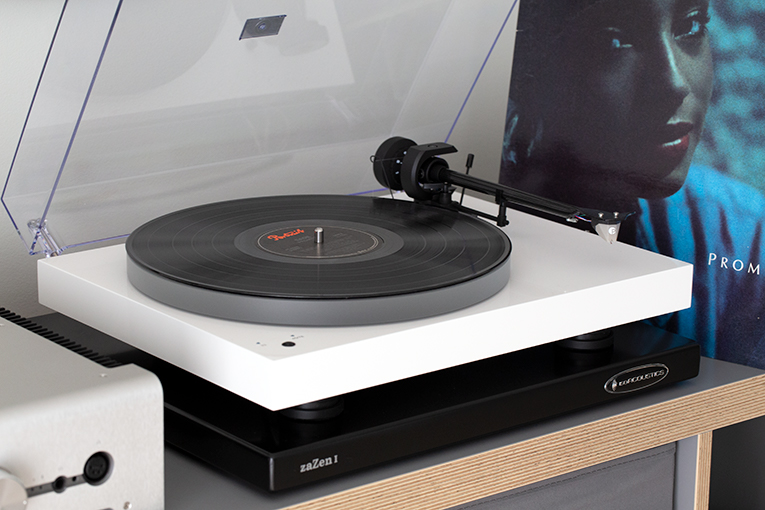
As I listened to “Mr Wrong” over and over, I periodically rested my left palm on the shelf’s top, then quickly moved it to various spots on the X1’s top deck. Ever since I stopped placing System One speakers on that top shelf, I’d thought little about any vibrations the IKEA might still be conducting. But as I quickly shifted my hand between shelf and turntable deck, I was more than a little surprised to feel the same vibration on the turntable as I did on the shelf. This vibration was clearly in sync with the music, increasing with louder sounds from the kick drum and other bass instruments. Nonetheless, to make sure that the X1’s motor wasn’t contributing anything, I let the platter spin without the stylus in the groove. The vibration stopped.
I think some of the vibrations I felt on the shelf and the X1’s top deck were from the soundwaves traveling through the room, but most of it likely had to do with energy from the speakers’ cabinets traveling down through their stands and into the floor, then into the Kallax and X1. Did the zaZen I affect what I could feel with my hand? Yes. While I could still feel vibrations on the X1’s plinth with the zaZen I in place, they felt only half as strong as they were without the platform -- and correlated with the subtle improvement in sound I heard. Yup -- external vibrations conveyed to a turntable structure can degrade a system’s sound.
With my son still performing zaZen-swapping chores, I next played three tracks from Trooper’s Hot Shots, a greatest-hits album from this Canadian classic-rock band (LP, MCA 5101): “The Boys in the Bright White Sports Car,” “Two for the Show,” and “Santa Maria.” Unfortunately, the sound of my 1979 pressing isn’t good -- limited bass weight and lots of compression, which restricts dynamic range. It also doesn’t sound that clean, and the LP has quite a bit of surface noise.
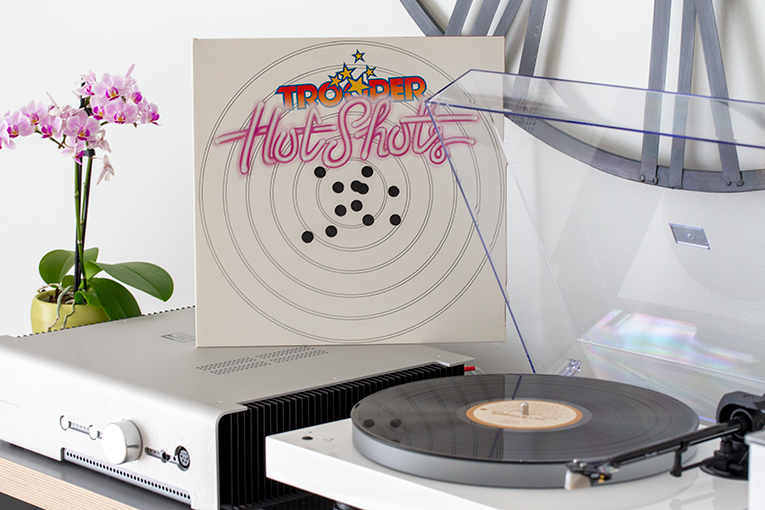
While through my hand I could still feel vibrations on the shelf and turntable deck, they weren’t as strong as they’d been with Sade’s Promise, probably because the relative lack of bass in Hot Shots produced less intense vibrations through the speakers, stands, floor, shelf, and plinth. But the difference, with and without the zaZen I, was the same: I felt about half as much vibration of the turntable’s deck with the zaZen I supporting it than I did when the Pro-Ject X1 sat directly on the IKEA shelf.
But through all of this, I had trouble hearing any differences at all, zaZen I or no zaZen I. It seemed that any differences the zaZen I platform made in the sound of my system were subtle enough to be masked by a poor and noisy recording.
We pressed on, this time playing “Once Upon a Time in the West”: track 1, side 1 of Dire Straits’ Communiqué (LP, Mercury SRM-1-3791). This recording has proper dynamic range and far greater bass weight than anything on Hot Shots, and the vibrations I felt on shelf and turntable were comparable with those I’d felt with Promise. Consistent with my previous tests, there was about a 50% reduction in the vibrations with the zaZen I platform in place.
For listening through my ears instead of through my palm, I used the first 30 seconds of “Once Upon a Time in the West,” focusing on Mark Knopfler’s lead guitar, which sounds as if played in a very large space, accompanied after 24 seconds by Pick Withers’s drumming. The differences I heard were still subtle, but more obvious than with Sade’s “Mr Wrong.” Most noticeable was that Knopfler’s guitar sounded smoother and cleaner with the zaZen I in place, as well as louder -- even though, throughout these tests, I never once touched the volume control. I chalk up that apparent loudness to perhaps a diminished noise floor -- or maybe because the sound was clearer. I’m not sure. The decays of his guitar notes lasted slightly longer, and extended farther out into the soundstage. I could hear little difference in the highs with the Sade LP, and none at all with Trooper’s Hot Shots -- but on Communiqué, Withers’s cymbals and the topmost frequencies of Knopfler’s guitar sounded cleaner. And Withers’s drums were reproduced with greater force and clarity, just as were the drums in “Mr Wrong.”
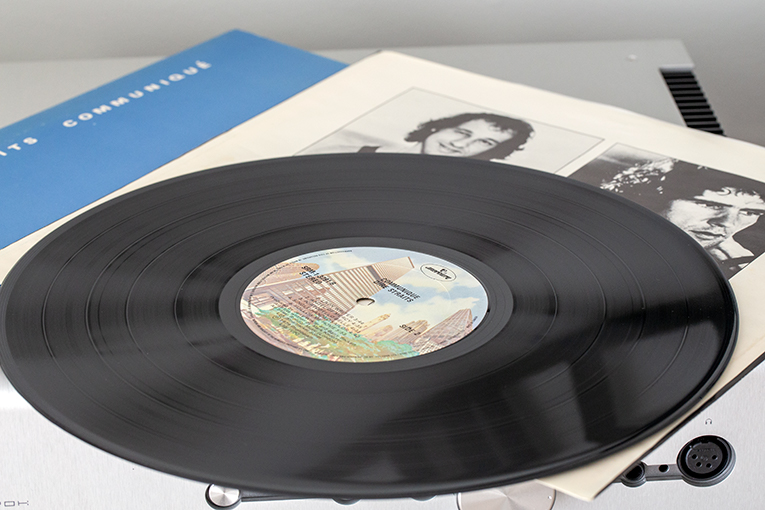
All told, the differences in System One’s sound wrought by the zaZen I weren’t as significant as what I heard when I placed a trio of IsoAcoustics’ Orea footers under each Paradigm Monitor SE Atom minimonitor sitting atop my old shelving unit, but that was a more expensive exercise -- $359.94 for the six Oreas, compared to $199.99 for the zaZen I. So, for the price, I’m content with the small improvements in sound the zaZen I brought to my system -- and I appreciate what it’s done for System One’s appearance.
My stand . . . on this stand
Those assembling a lower-priced audio system don’t usually consider expensive cables and interconnects, let alone such tweaks as isolation devices -- their budgets just can’t stretch that far. To get the most bang for their buck, budget shoppers should focus on getting the best source component(s), amplification, and speakers -- the primary elements of any hi-fi system -- that they can afford. But if an isolation device or other tweak costs little enough and provides legitimate benefits, audible or otherwise, well, that’s a different story.
The IsoAcoustics zaZen I made my turntable look nicer by quite literally putting it on a pedestal. I’m not joking about that -- many people find their turntables as beautiful to look at as to listen to -- but it’s certainly not the most important basis on which to buy an audio device. That basis will always be sound quality, and in that regard, there was no question that the zaZen I damped the transmission of vibrations from my Kallax shelving unit to my turntable -- a difference I could easily feel through my palm.
Hearing that difference wasn’t as easy -- with my current System One setup, the improvements I heard across the audioband were subtle. Nonetheless, they were enough for me to believe that, for those who want to improve the sound of a turntable they’re already pleased with, $199.99 isn’t too much to pay. Visually and sonically, the zaZen I is a fairly inexpensive upgrade that produces a real improvement.
. . . Doug Schneider
das@soundstagenetwork.com






















